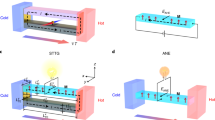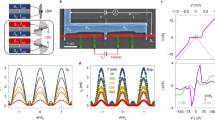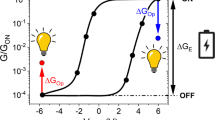Abstract
Thyristors are a class of nonlinear electronic device that exhibit bistable resistance—that is, they can be switched between two different conductance states1. Thyristors are widely used as inverters (direct to alternating current converters) and for the smooth control of power in a variety of applications such as motors and refrigerators. Materials and structures that exhibit nonlinear resistance of this sort are not only useful for practical applications: they also provide systems for exploring fundamental aspects of solid-state and statistical physics. Here we report the discovery of a giant nonlinear resistance effect in the conducting organic salt2 θ-(BEDT-TTF)2CsCo(SCN)4, the voltage-current characteristics of which are essentially the same as those of a conventional thyristor. This intrinsic organic thyristor works as an inverter, generating an alternating current when a static direct-current voltage is applied. Whereas conventional thyristors consist of a series of diodes (their nonlinearity comes from interface effects at the p-n junctions), the present salt exhibits giant nonlinear resistance as a bulk phenomenon. We attribute the origin of this effect to the current-induced melting of insulating charge-order domains, an intrinsically non-equilibrium phenomenon in the sense that ordered domains are melted by a steady flow.
This is a preview of subscription content, access via your institution
Access options
Subscribe to this journal
Receive 51 print issues and online access
$199.00 per year
only $3.90 per issue
Buy this article
- Purchase on Springer Link
- Instant access to full article PDF
Prices may be subject to local taxes which are calculated during checkout





Similar content being viewed by others
References
Streetman, B. G. Solid State Electronic Devices 2nd edn, Ch. 11 (Prentice-Hall, Englewood Cliffs, 1980)
Mori, H., Tanaka, S. & Mori, T. Systematic study of the electronic state in θ-type BEDT-TTF organic conductors by changing the electronic correlation. Phys. Rev. B 57, 12023–12029 (1998)
Seo, H. Charge ordering in organic ET compounds. J. Phys. Soc. Jpn 69, 805–820 (2000)
Clay, R. T., Mazumdar, S. & Campbell, D. K. Charge ordering in θ-(BEDT-TTF)2X materials. J. Phys. Soc. Jpn 71, 1816–1819 (2002)
Nogami, Y. et al. Structural modulation in θ-(BEDT-TTF)2CsM′(SCN)4[M′ = Co, Zn]. Synth. Met. 103, 1911 (1999)
Watanabe, M., Nogami, Y., Oshima, K., Mori, H. & Tanaka, S. Novel pressure-induced 2kF CDW state in organic low-dimensional compound θ-(BEDT-TTF)2CsCo(SCN)4 . J. Phys. Soc. Jpn 68, 2654–2663 (1999)
Mori, T. Non-stripe charge order in the θ-phase organic conductors. J. Phys. Soc. Jpn 72, 1469–1475 (2003)
Nishio, Y. et al. Specific heat and metal-insulator transition of (BEDT-TTF)2MZn(SCN)4 (M = Cs, Rb). Synth. Met. 103, 1905–1906 (1999)
Takahashi, T. et al. Charge ordering in non-dimerized BEDT-TTF based organic conductors: 13C-NMR experiments. Phys. IV Fr. 12(Pr9), 201–204 (2002)
Inagaki, K., Terasaki, I., Mori, H. & Mori, T. Large dielectric constant and giant nonlinear conduction in the organic conductor θ-(BEDT-TTF)2CsZn(SCN)4 . J. Phys. Soc. Jpn 73, 3364–3369 (2004)
Maeda, A., Notomi, M., Uchinokura, K. & Tanaka, S. Evidence for the existence of the inherent periodicity in the switched state at low temperatures in K0.3MoO3 . Phys. Rev. B 36, 7709–7711 (1987)
Gunn, J. B. Microwave oscillations of current in III–V semiconductors. Solid State Commun. 1, 88–91 (1963)
Gruner, G. Density Waves in Solids 56–57 (Addison-Wesley, Reading, Massachusetts, 1994)
Acknowledgements
We thank K. Inagaki for collaboration, and A. Maeda for technical advice for nonlinear-conduction and noise measurements. We also thank S. Tasaki, S. Kurihara, M. Abdel-Jawad, and N. E. Hussey for discussions. This work was partially supported by MEXT, the Grant-in-Aid for Scientific Research, and by the 21st Century COE Program at Waseda University. Author Contributions F.S. did the electrical measurement, I.T. did the project planning and analysis, H.M. and T.M. did the sample preparation and chemical characterization, and M.W., N.I., Y.N. and Y.N. did the diffraction in electric fields.
Author information
Authors and Affiliations
Corresponding author
Ethics declarations
Competing interests
Reprints and permissions information is available at npg.nature.com/reprintsandpermissions. The authors declare no competing financial interests.
Rights and permissions
About this article
Cite this article
Sawano, F., Terasaki, I., Mori, H. et al. An organic thyristor. Nature 437, 522–524 (2005). https://doi.org/10.1038/nature04087
Received:
Accepted:
Issue Date:
DOI: https://doi.org/10.1038/nature04087
This article is cited by
-
Correlation-driven organic 3D topological insulator with relativistic fermions
Nature Communications (2023)
-
Stark effect and dissociation of mesons in holographic conductor
Journal of High Energy Physics (2023)
-
Electric-field driven nonequilibrium phase transitions in AdS/CFT
Journal of High Energy Physics (2023)
-
A novel n-type semiconducting biomaterial
Scientific Reports (2022)
-
Electric-field-induced metal maintained by current of the Mott insulator Ca2RuO4
Scientific Reports (2013)
Comments
By submitting a comment you agree to abide by our Terms and Community Guidelines. If you find something abusive or that does not comply with our terms or guidelines please flag it as inappropriate.



